
Gateleg table, Newport, Rhode Island, 1710–1740. Maple with white pine and chestnut. H. 28", W. 59 1/8" (open), D. 48 3/8". (Private collection; photo, Gavin Ashworth.)
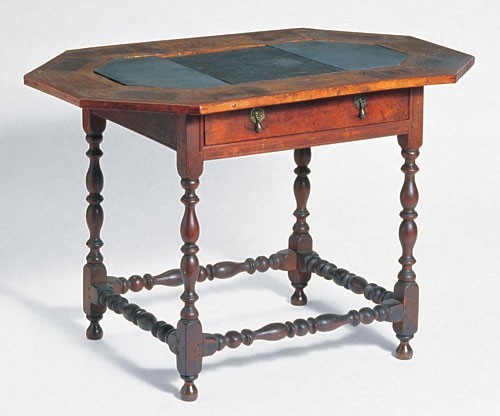
Table, Boston, Massachusetts, 1700–1730. American walnut, European walnut, and fruitwood with white pine; slate. H. 27 1/4", W. 40", D. 25 1/8". (Courtesy, American Antiquarian Society.) This table originally belonged to the Reverend Nehemiah Walter (1663–1751) of Roxbury, Massachusetts.

Tea table, Boston, Massachusetts, 1700–1730. Mahogany. H. 26 1/2", W. 32 1/2", D. 21 3/4". (Private collection; photo, Gavin Ashworth.)
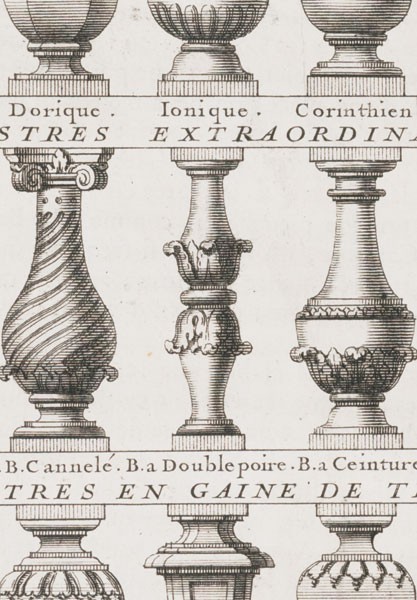
Baluster design illustrated on pl. 94 in Augustin-Charles d’Aviler’s Cours d’architecture qui comprend les ordres de Vignole (1691). (Courtesy, Beinecke Rare Book and Manuscript Library, Yale University.)

Detail of a staircase in Harvard House, Stratford-upon-Avon, Warwickshire, England, late seventeenth century. (Courtesy, Shakespeare Birthplace Trust.) Built in 1596, this house was the boyhood home of John Harvard (1607–1683), founder of Harvard University.

Detail of the balusters leading to the gallery of the Seventh Day Baptist Meeting House, Newport, Rhode Island, ca. 1730. (Courtesy, Newport Historical Society; photo, Gavin Ashworth.)
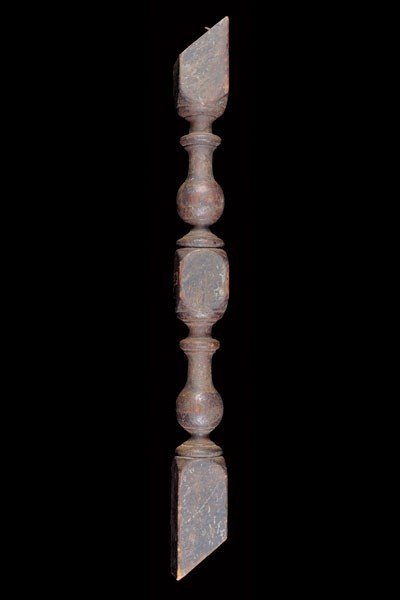
Baluster from the staircase in the Governor William Coddington House (demolished in 1835), Newport, Rhode Island, ca. 1641. (Courtesy, Newport Historical Society; photo, Gavin Ashworth.) This staircase baluster salvaged from the house likely dates to ca. 1730.
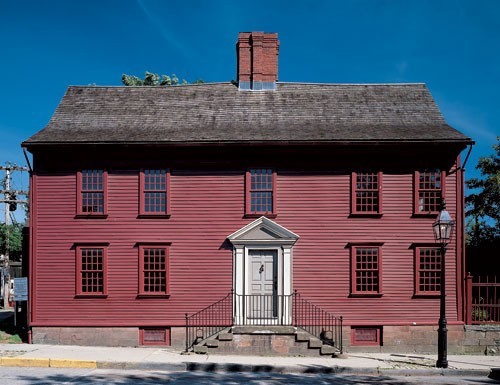
Wanton-Lyman-Hazard House, Newport, Rhode Island, ca. 1697. (Photo, Gavin Ashworth.) One of the few surviving Newport buildings with details rooted in baroque classicism, this house has undergone extensive renovations during its history.

Detail of the staircase in the Wanton-Lyman-Hazard House. (Photo, Gavin Ashworth.) This staircase was probably added during an eighteenth-century renovation.
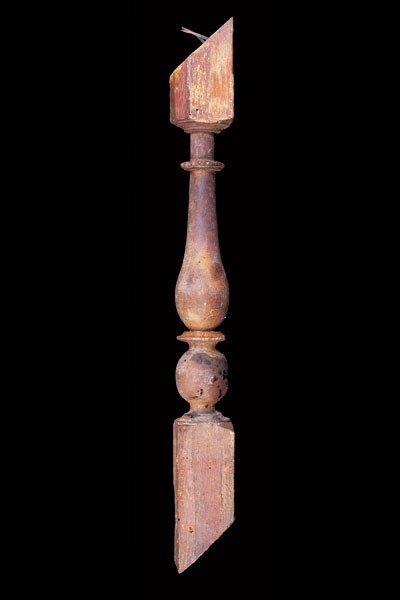
Detail of a baluster from the staircase in the Wanton-Lyman-Hazard House. (Photo, Gavin Ashworth.) This oak baluster was part of what was likely the original attic staircase.

Table, Newport, Rhode Island, 1700–1730. Maple with white pine, H. 26 3/4", W. 54 3/4", D. 28 5/8". (Courtesy, National Park Service, William Floyd Estate.) This table was originally constructed as a draw-bar table. The drawer is a later addition, the top is a replacement, and the feet are missing.
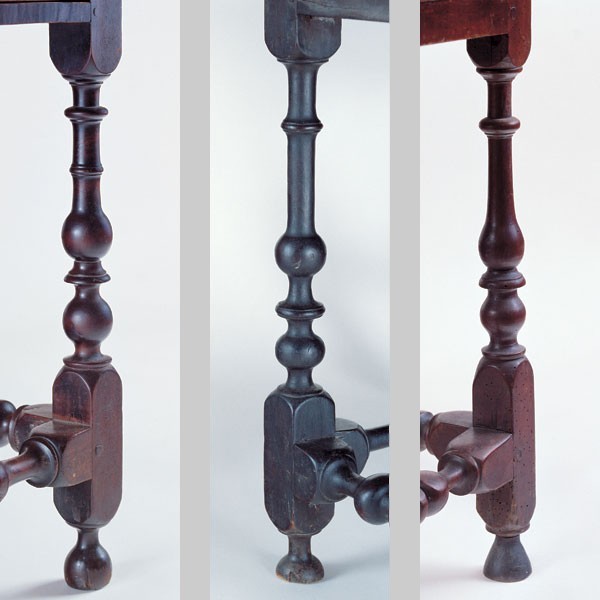
Details of the legs of the gateleg tables illustrated (from left to right) in figs. 1, 19, 21. The leg on the left is from a table in group one, the leg in the center is from a table in group two, and the leg on the right is from a table in group three. (Photos, Gavin Ashworth.)

Gateleg table, Newport, Rhode Island, 1710–1740. Maple with white pine and oak. H. 27 3/4", W. 60" (open) 21 1/4", D. 48 1/4". (Private collection; photo, P. Richard Eells.)
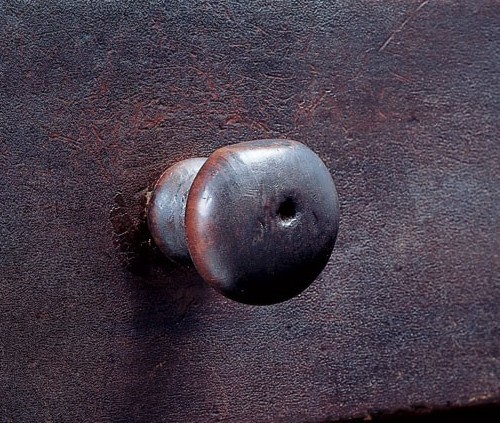
Detail of the drawer knob of the gateleg table illustrated in fig. 13. (Photo, Gavin Ashworth.)
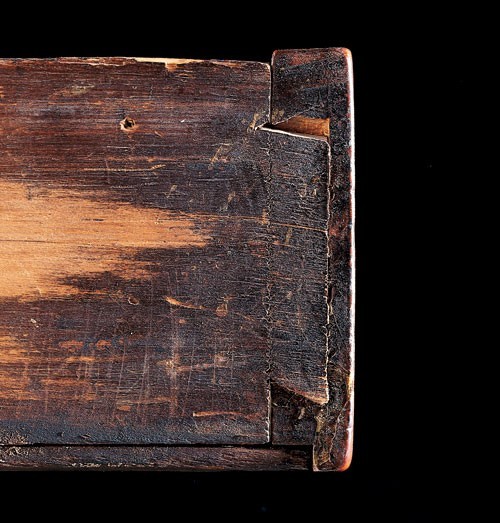
Detail of the drawer dovetail of the gateleg table illustrated in fig. 13. (Photo, Gavin Ashworth.)
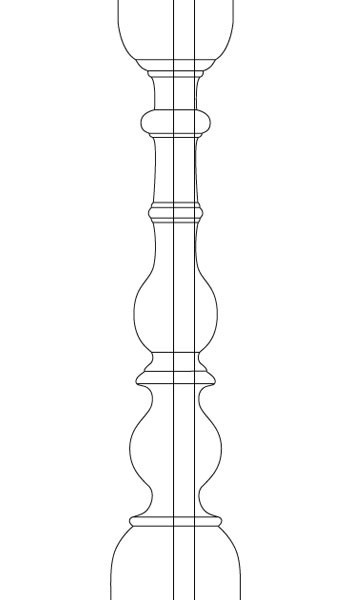
Drawing representing how the stationary legs of the table illustrated in fig. 1 are laminated, (Artwork, Wynne Patterson.)

Gateleg table, Newport, Rhode Island, 1710–1740. Maple with white pine. H. 28", W. 57 3/4" (open), D. 48 3/8". (Courtesy, Metropolitan Museum of Art, gift of Mrs. Russell Sage.)

Detail of the stationary leg of the gateleg table illustrated in fig. 17. (Photo, Gavin Ashworth.)

Gateleg table, Rhode Island, 1710–1740. Maple with unidentified secondary woods. H. 27", W. 53 1/2" (open), D. 49 1/2". (Courtesy, Nathan Liverant & Son, Inc.)

Underside of the gateleg table illustrated in fig. 13. The rectangular hinges are positioned outside the frame and the gates pivot at the same end.

Gateleg table, Rhode Island, 1710–1740. Maple with white pine. H. 27 1/4", W. 41" (open), D. 49 5/8". (Private collection; photo, Gavin Ashworth.)
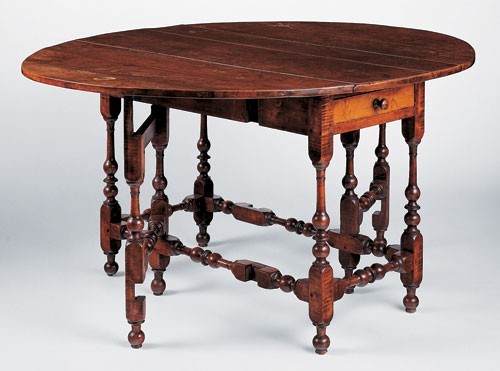
Gateleg table, Rhode Island, 1710–1740. Maple with white pine and cherry. H. 28 1/2", W. 57" (open), D. 47 3/4". (Chipstone Foundation; photo, Gavin Ashworth.)

Detail of the stationary leg of the gateleg table illustrated in fig. 22. (Photo, Gavin Ashworth.)

Side chair, Rhode Island, 1710–1740. Ash. H. 49 1/2", W. 20 1/4", D. 15". (Private collection; photo, Gavin Ashworth.) The crest, finials, and bottom row of stretchers are replacements.

Gateleg table, Rhode Island, 1710–1740. Maple. H. 27 3/4", W. 59" (open), D. 47 1/4". (Private collection; photo, Gavin Ashworth.) The feet are replacements.

Detail of a wrought-iron hinge on the gateleg table illustrated in fig. 25.
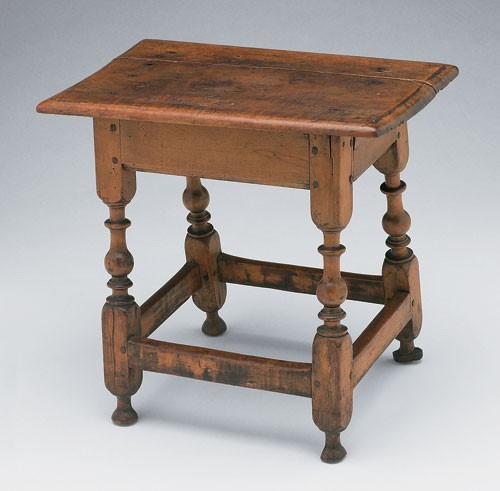
Stool, Newport, Rhode Island, 1710–1740. Maple. H. 21 1/4", W. 22 1/8", D. 13 1/2". (Courtesy, Yale University Art Gallery, gift of C. Sanford Bull, B.A. 1893.) Although the lower ball turning is omitted, the rings and moldings of this stool are virtually identical to those on the gateleg tables in group one.
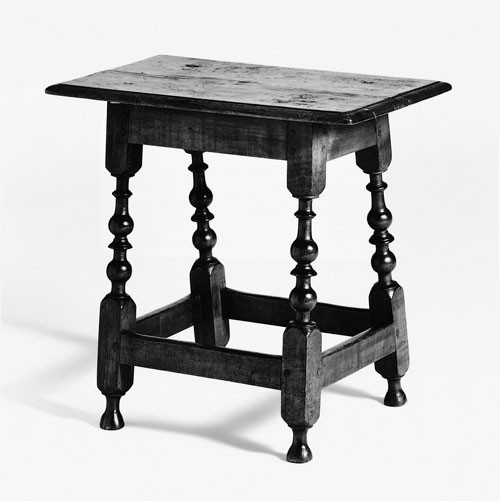
Stool, Newport, Rhode Island, 1710–1740. Maple. H. 22", W. 13 1/4", D. 23 1/4". (Courtesy, Winterthur Museum.)
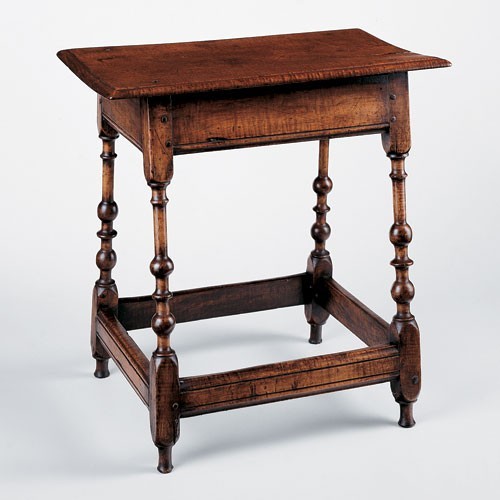
Table, Rhode Island, 1710–1740. Maple. H. 25 7/8", W. 15 1/2", D. 26". (Private collection; photo, Gavin Ashworth.)
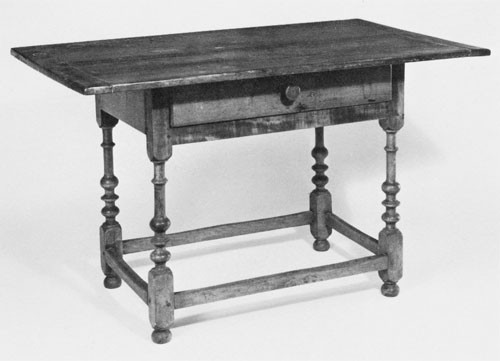
Table, Rhode Island, 1710–1740. Maple with white pine. H. 29", W. 48", D. 29 3/4". (Courtesy, Sotheby’s Inc.)
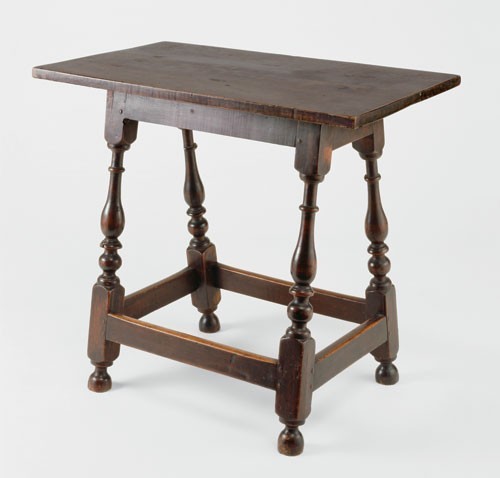
Table, Rhode Island, 1710–1740. Maple frame. H. 22 7/8", W. 15 1/2", D. 23 3/4". (Private collection; photo, Gavin Ashworth.) The top is an incorrect replacement.

Table, Rhode Island, 1710–1740, Maple. H. 23 1/2", W. 20", D. 28 3/4". (Private collection.)
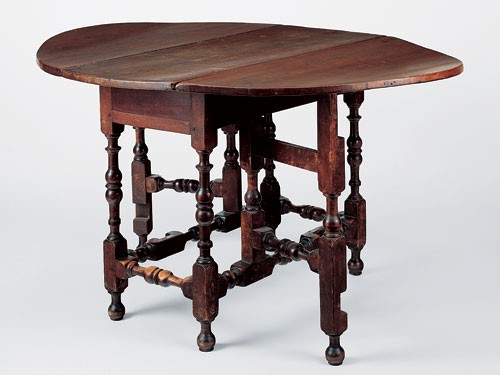
Gateleg table, probably Rhode Island, 1710–1740. Maple. H. 25 1/2", W. 53 3/4" (open), D. 42". (Private collection; photo, Gavin Ashworth.) The feet are replaced.

Gateleg table frame, probably Rhode Island, 1710–1740. Maple. H. 25 5/8", W. 15 7/8", D. 31 7/8". (Private collection; photo, Gavin Ashworth.)
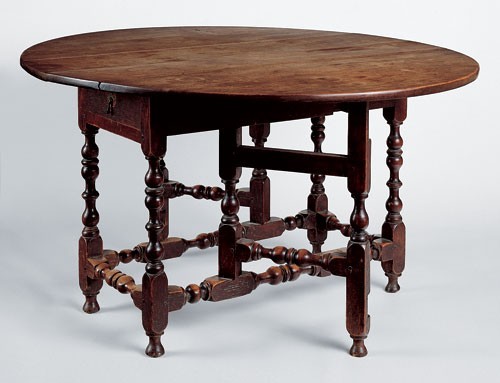
Gateleg table, probably Rhode Island, 1710–1740. Maple. H. 27", W. 53" (open), D. 48". (Private collection; photo, Gavin Ashworth.)

Table, probably Rhode Island, 1710–1740. Maple with oak and white pine. H. 26", W. 24", D. 17". (Private collection; courtesy, Peter Eaton Inc.)
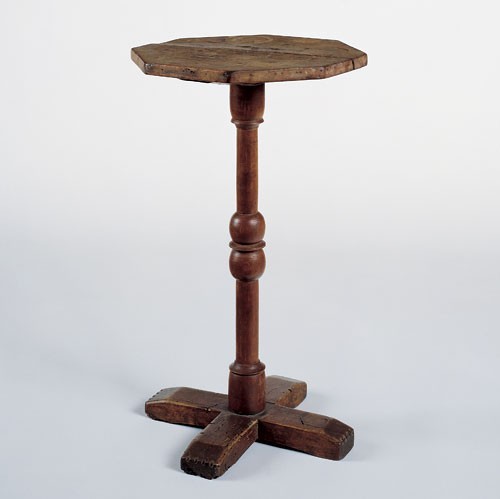
Candlestand, probably Rhode Island, 1710–1740. Maple. H. 23 3/4", W. 13 1/2", D. 13 1/4". (Private collection; photo, Gavin Ashworth.)
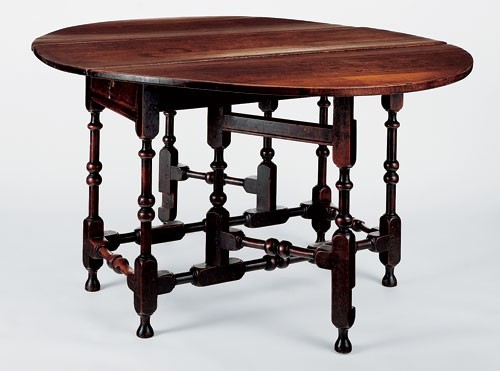
Gateleg table, probably Rhode Island, 1710–1740. Maple. H. 27", W. 53 3/4" (open), D. 45 3/4". (Private collection; photo, Gavin Ashworth.)
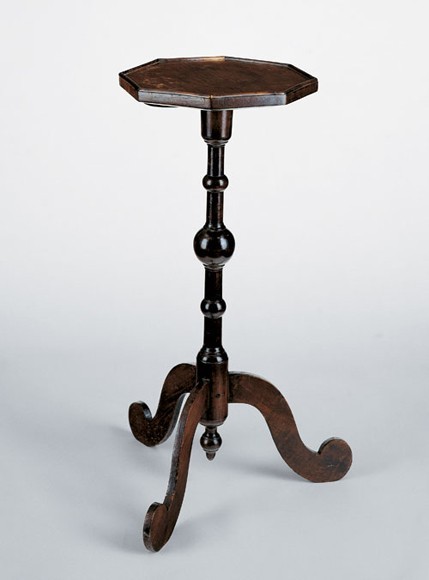
Candlestand, probably Rhode Island, 1710–1740. Maple. H. 29 1/8", W. 12 3/4", D. 12 5/8". (Private collection; photo, Gavin Ashworth.)
